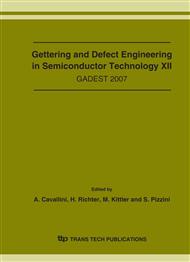p.511
p.517
p.523
p.529
p.535
p.541
p.547
p.553
p.559
Growth and Properties of Silicon Nanowires for Low-Dimensional Devices
Abstract:
The generation of semiconductor nanowires (NWs) by a “bottom-up” approach is of technological interest for the development of new nanodevices. In most cases Si and SiGe nanowires (NWs) are grown by molecular beam epitaxy (MBE) and by chemical vapor deposition (CVD) on the base of the vapor-liquid-solid-mechanism (VLS). In both cases small metal droplets act as a seed for the NW formation. The article mainly refers to the specific features of the MBE growth. The application of metals related to the VLS growth concept (quite often gold droplets are used) also causes several disadvantages of this approach, e.g., the formation of a metal wetting layer on all surfaces, dislocations, and electric active point defects. Concerning the formation of devices, technological steps, such as oxidation and doping of NWs, have to be considered. Specific techniques have to be applied to investigate the properties of individual semiconductor NWs. Some examples shall illustrate this topic.
Info:
Periodical:
Pages:
535-540
Citation:
Online since:
October 2007
Authors:
Keywords:
Price:
Сopyright:
© 2008 Trans Tech Publications Ltd. All Rights Reserved
Share:
Citation:


